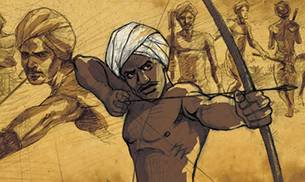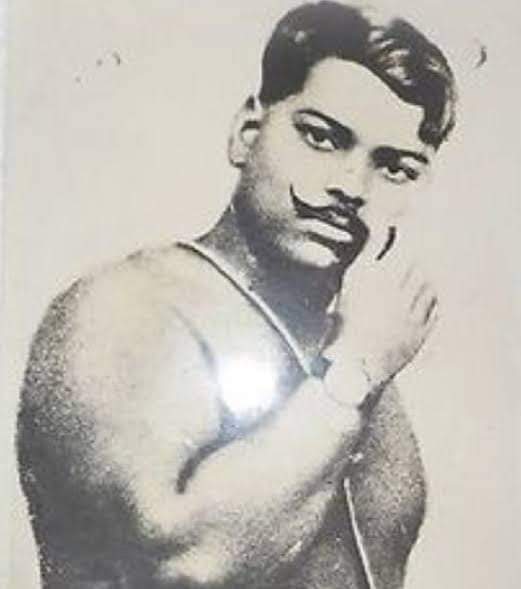Bhagavan Birsa Munda who led a tribal uprising against the British rule in Jharkhand, only tribal leader whose portrait hangs in Central Hall of Parliament and whose Jayanti is celebrated as #JharkhandDay. Thread on his death anniversary today. 

Jharkhand whose name literally means “Bush land” or “Forest land” had a long history of resistance to the British colonial rule. Among the numerous tribes that make up the state, the Santhals are one of the dominant ones. #BirsaMunda
The Santhals are located primarily in the south eastern part of the Chotanagpur plateau and Midnapore in West Bengal. While they lived in the valley, the Mal Paharias primarily inhabited the hills.
The British acquired the Junglemahal region, primarily covering Midnapore, Burdwan, Birbhum and Bankura, from Siraj-ud-daulah in 1750, followed by taking over the Santhal Parganas, Chotanagpur in 1765, and the entire Dewani of Bengal, Bihar, Odisha after their victory at Buxar.
With the East India Company directly collecting taxes, they collaborated with the mahajans( money lenders) to grab the tribal land against unpaid loans. The tribals were in effect reduced to tenants or laborers on their own lands.
Also the British followed a policy of divide and rule, pitting the hill dwelling Paharias who were more nomadic, followed the Jhum( slash and burn) cultivation, against the Santhals who lived in the valley and practiced a more settled form of cultivation.
The state saw many resistance movements by tribal leaders against the British the first was was Tika Manjhi in 1784, a Paharia leader who led the resistance in the Rajmahal hills and was later hanged at Bhagalpur.
Another well known resistance movement in Jharkhand was the Santhal revolt in 1855 by the 4 Murmu brothers, Sidhu, Kanhu, Chand and Bhairav. The revolt was put down brutally by British sepoys, Sidhu and Kanhu were killed along with 15,000 other tribals.
And the most famous one was that of Birsa Munda in Jharkhand, the only tribal leader whose portrait hangs in Parliament Central Hall and whose Jayanti is celebrated as Jharkhand Day too.
Birsa Munda was born on November 15, 1875, in the tribal hamlet of Ulihatu to Suguna Munda and Karmi Hatu in Jharkhand’s Khunti district , though some versions state it as Chalkad. He got his name from the fact that he was born on a Thursday as per the custom of the Munda tribe.
His parents along with his younger brother Pasna Munda, left Ulihatu and migrated to Kurumbda, near Birbanki, to work as farm labor. He grew up with his parents at Chalakkad, and his childhood life was like any normal Munda kid. #BirsaMunda
Grazing sheep in the forests of Bohonda, he often played the tulla, a one stringed instrument made from pumpkin, as well as the flute. Well built and tall, he was a good wrestler too. He spent some time at his maternal uncle’s village Ayubhatu. #BirsaMunda
As he was good at studies, his school teacher Salga Nag, recommended him to study at a German Missionary school. However with the tribal sardar’s agitation against Christian missionaries and conversions, his father removed him from the school. #BirsaMunda
He came under the influence of the Vaishnava devotee Anand Pandey, and his stay in Chaibasa from 1886-1890 in a way shaped his own thoughts and ideology. It was the period when the tribal Sardars launched an agitation against the missionaries, and the Govt. #BirsaMunda
It was against both the unjust taxation of the colonial Government, as well the proselytizing activities of the missionaries. Under the Indian Forest Act, the Government took control of all the forest and village areas, depriving tribals of their own land.
The officials marked off large tracts of forest land, that consisted of both waste as well as cultivable land as per their convenience. In a way the Indian Forest Act, deprived the tribals from cultivating their own lands, and denying them rights over the forest produce.
Coming from the poorest of poor, Birsa Munda, more than any one else, was well acquainted with the misery of the ryots and tribals. Most of his growing up years, were of a nomadic nature, moving from place to place in search of employment.
His experiences as a laborer at various places, gave him an insight into the problems faced by the peasants and tribals. During the British time, the non tribals, were invited by the tribal Sardars to take over the land and cultivate it. #BirsaMunda
These non tribals known as Thikadars, were one of the most greedy, ruthless lot and together with the British looted the tribals . By 1874, most of the tribals had lost possesion of their lands, and were reduced to mere serfs, living in the most pitiable conditions. #BirsaMunda
Birsa Munda, now began to mobilize the tribals against the British rulers, as well as their middle men like the Thikadars.
Abua raj seter jana, maharani raj tundu jana.-
Let the kingdom of the queen be ended and our kingdom be established, this was Birsa’s slogan.
Abua raj seter jana, maharani raj tundu jana.-
Let the kingdom of the queen be ended and our kingdom be established, this was Birsa’s slogan.
Consider this in 1856, tribals had possesion of around 600 Jagirs and owned around 150 villages in Chotanagpur region itself. By 1874, with the non tribal Thekedars taking control, they completely lost control of their lands, reduced to serfs.
Birsa Munda’s movement was to assert the tribals as the real land owners and expulsion of British, Thikadars. Adopting guerilla tactics, he launched a series of armed attacks on the Thikadars and the British Govt.
With his excellent oratory skills, good organization skills, Birsa Munda managed to rally the various tribal communities in the forests of Chotanagpur, Odisha, Bengal against the British. #BirsaMunda
He bought together the Oraons, Kharias on to a common platform agains the British-Thekedar combine, forging a tribal unity. His fight was also to save the native traditions of the tribals, from the Christian missionaries. #BirsaMunda
He vigorously campaigned against Cow Slaughter, urging the tribal communities to protect cattle.Soon the movement spread like wildfire in the Chotanagpur region, and Birsa Munda became one of the most wanted men by the British.
He harassed the Thekedars and British, with a series of guerilla attacks, and soon the revolt was a major worry for them. He was arrested following a rumor that those who did not follow him would be massacred. #BirsaMunda
Released from prison in January 1898, he once again began to re-organize his men, went underground for some time. Around 7000 assembled in December 1899 to herald the ugulaan(revolution) that soon spread to Khunti, Tamar and Ranchi. #BirsaMunda
The Birsaits, as his followers were called, targeted the Anglican Mission at Muthu and the Roman Catholic mission at Sarwada, and for close to a year they regularly harassed the British. #BirsaMunda
On January 5, 1900 they attacked two constables at Etkedih, while 2 days later,the police station at Khunti was attacked, killing a constable.
The British stuck back, sending their commisioner A.Forbes and Dy.Comissioner H.C. Streattfield to Khunti with a force of 1500 to surpress the revolt.Munda guerillas were indiscriminately fired on at Dumbari Hill, while Birsa escaped to the hills of Singhbum. #BirsaMunda
Finally the British managed to arrest him on March 3, 1900, when he was sleeping in the Jamkopai forest near Chakradharpur, through a stealth operation. Around 460 of Birsa’s associates were arrested, one of them was given capital punishment, 30 deported to Cellular Jail.
Apparently Birsa Munda passed away in Ranchi jail of cholera, on June 9, 1900. Though many versions, state that the British actually executed him in prison, but showed as if cholera was the cause.
He died at a very young age of 25, but the impact he made on the movement was quite significant. Though his movement died out, it forced the British Govt, to introduce laws that prohibited non tribals from occupying tribal lands. #BirsaMunda
His revolt led to a series of similiar tribal revolts against British rule throughout India, which have not really got their due. Incidentally the war cry of Bihar Regiment is Birsa Munda ki Jai, he is pretty much of a folk hero in the tribal parts. #BirsaMunda
The airport in Ranchi is named after Birsa Munda, as is BIT at Sindri. Also the university at Purulia, the Agricultural University at Ranchi are all named after him. #BirsaMunda
Mahasweta Devi’s historical novel Aranyer Adhikar for which she won the Sahitya Akademi award is based on Birsa Munda’s life. She also wrote an abridged version of Birsa Munda’s life story for younger readers. #BirsaMunda
On his death anniversary today, my tributes to #BirsaMunda who led the tribal uprising in Jharkhand, and fought against the British colonial rulers as well as the missionaries there. #Naman
My article here on Birsa Munda on his death anniversary today do check out and share.
historyunderyourfeet.wordpress.com/2019/06/09/bir…
historyunderyourfeet.wordpress.com/2019/06/09/bir…
My podcast here on Birsa Munda on his death anniversary today do check out and share.
spotifyanchor-web.app.link/e/VqUrP3KVXub
gaana.com/song/birsa-mun…
spotifyanchor-web.app.link/e/VqUrP3KVXub
gaana.com/song/birsa-mun…
• • •
Missing some Tweet in this thread? You can try to
force a refresh

 Read on Twitter
Read on Twitter







